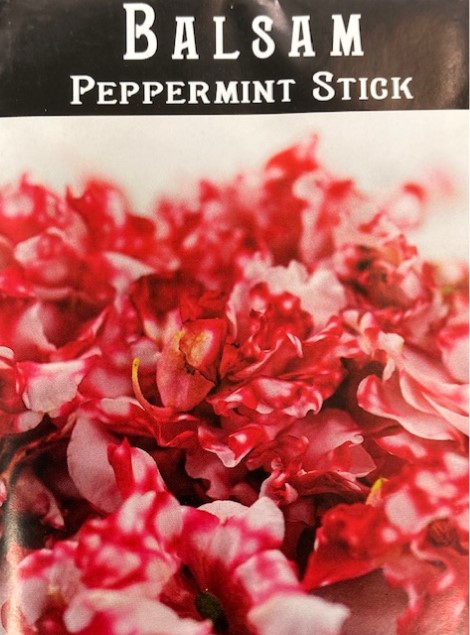
Balsam
Balsam is also known as “Touch-Me-Not” for its exploding seed pods. The leaves are used in curries and the flowers provide food for bees and other insects and birds!
|
Peppermint Stick |
|
Impatiens balsamina |
|
Easy |
|
Easy |
|
2-5 years if properly stored |
|
Annual |
|
7-15 days |
|
75 F |
|
None |
|
Surface Sow |
|
up to 18” |
|
Needs light to germinate Part shade, will tolerate full sun |
|
Spring |
|
February and March |
|
No |

Growing Tips



When to Start
Spring: Start indoors 6-8 weeks before the last frost date. (February/March for GA)
Direct sow: after the danger of frost has passed. (May 1 for Jefferson, GA)
How to Grow
While you can direct sow balsam after the danger of frost has passed, you might have better luck with starting them indoors and transplanting. Start indoors 6-8 weeks before the last frost. (February/March for GA). Use sterile, premoistened seed starting mix. Surface sow by gently pressing the seeds into the seed starting mix as balsam needs light to germinate. Then place the cells or pots under grow lights.
Like other impatiens, balsam germinates best at a consistent 75 F. The seeds may rot if not maintained at this temperature. A heat mat would be beneficial to maintain a constant and even temperature.
Balsam prefers part shade. Adjust the grow lights by dimming them if they have that option. Or after the seedlings have emerged create more distance from the grow lights so the light isn’t as strong. Monitor and adjust as needed. They will still need 14-16 hours of light ONLY as seedlings. When you start to harden them off, you are acclimating them to the conditions they will live in, which is part shade. After hardening off, transplant after all danger of frost has passed. (May 1 for GA).
Care
Transplant balsam into part shade beds. They like rich, well-draining, and moist soil–but NOT soggy. When the soil feels dry to the touch one inch down, water slowly and deeply. Bottom water as the plants are susceptible to powdery mildew and space 12” apart to help with air circulation. A soaker hose is a great and easy way to bottom water. They will tolerate full sun, but it is recommended that they be protected from the hot afternoon sun. Balsam likes temperatures that range from 60-90 F.
Seed Saving

Isolation Distance
Insect dependent for pollination. Isolate ½ mile to prevent cross-pollination.
Instructions
Select healthy, robust plants free of any signs of disease or insect infestation for seeds. Seeds carry the traits of the parent plant. Choose plants that exhibit the traits you wish to preserve. Consider bloom size, color, and shape, as well as blooming time.
Allow the biggest and healthiest blooms to mature on the plant. Cover the seed head with a fine-mesh bag as soon as the flowers begin to wilt. Use an elastic band to hold the bag in place. This prevents seeds from spilling onto the soil before harvest.
After the seeds explode in the bag, separate plant debris from the seeds by removing the mesh bag and placing the flower head in a paper bag, and shake to loosen the seeds. Seeds settle to the bottom of the bag. Remove plant debris by hand.
Features
- Attracts pollinators
- Attracts birds
- Container friendly
- Drought tolerant
- Good for borders
- Good cut flowers
- Leaves are edible when cooked and good in curries
- Peppermint Stick: Heirloom. Popular in the Victorian area, the potted and striped ruffled flowers in bright white and candy apple red that bloom in summer. Rare and hard to find.

Powdery mildew can be a challenge for balsam. Bottom watering with soaker hoses or drip irrigation is immensely helpful in keeping the leaves dry. Proper spacing will increase circulation allowing the leaves to dry from any morning dew or rainfall.
Sources:
Edenbrothers.com
